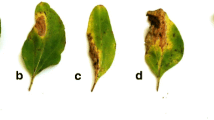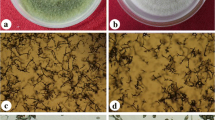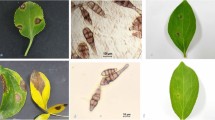Abstract
Onion (Allium cepa) is an important globally cultivated crop and is known to be susceptible to purple blotch caused by Alternaria porri. The causal pathogens of blight symptoms from onion in Myanmar were isolated and identified. In addition to Stemphylium vesicarium, a large-spored Alternaria with unique morphology as well as a small-spored Alternaria were obtained. To identify the two Alternaria fungal pathogens, morphological characteristics and molecular phylogenies based on multigene sequence analysis of the internal transcribed spacer of ribosomal DNA (ITS) region, glyceraldehyde-3-phosphate dehydrogenase (GAPDH), Alternaria major allergen (ALT), translation-elongation factor 1 (EF1-α), and RNA polymerase second largest subunit (RPB2) genes were used. This revealed the presence of a small-spored Alternaria, A. burnsii, and a new large-spored species here described as A. cepae sp. nov. The novel species is morphologically distinct from its closely related species of A. montanica. Pathogenicity assays revealed that Stemphylium vesicarium, A. burnsii, and A. cepae were the causal agents of the onion leaf blight of the current study, and that A. cepae exhibited the most virulence. However, A. porri, which has been reported as the most important onion pathogen worldwide, was absent during this investigation.



Similar content being viewed by others
Data availability
All data generated or analyzed during this study are included in this published article (and its supplementary files). All sequences data generated in this study are available in NCBI GenBank.
References
Al-Nadabi H, Maharachchikumbura S, Agrama H, Al-Azri M, et al. (2018) Molecular characterization and pathogenicity of Alternaria species on wheat and date palms in Oman. Eur J Plant Pathol 152.https://doi.org/10.1007/s10658-018-1550-4
Andersen B, Krøger E, Roberts RG (2001) Chemical and morphological segregation of Alternaria alternata, A. gaisen and A. longipes. Mycol Res 105:291–299. https://doi.org/10.1017/S0953756201003446
Aveling TAS, Snyman HG, Naude SP (1993) Evaluation of seed treatments for reducing Alternaria porri and Stemphylium vesicarium on onion seed. Plant Dis 77:1009–1011. https://doi.org/10.1094/PD-77-1009
Berbee ML, Pirseyedi M, Hubbard S (1999) Cochliobolus phylogenetics and the origin of known, highly virulent pathogens, inferred from ITS and glyceraldehyde-3-phosphate dehydrogenase gene sequences. Mycologia 91:964–977. https://doi.org/10.1080/00275514.1999.12061106
Black L, Conn K, Gabor B, Kao J, Lutton J (2012) Purple blotch. In: Conn KE, Lutton JS, Rosenberger SA (eds) Onion disease guide. Seminis Vegetable Seeds Inc., St. Louis
Carbone I, Kohn ML (1999) A method for designing primer sets for speciation studies in filamentous ascomycete. Mycologia 91:553–556. https://doi.org/10.1080/00275514.1999.12061051
Cenis JL (1992) Rapid extraction of fungal DNA for PCR amplification. Nucleic Acids Res 20:2380. https://doi.org/10.1093/nar/20.9.2380
Chun J (1995) Computer assisted classification and identification of actinomycetes. Dissertation, Unversity of Newcastle. http://theses.ncl.ac.uk/jspui/handle/10443/410
Crous PW, Wingfield MJ, Richardson DM et al (2016) Fungal planet description sheets: 400–468. Persoonia 36:316–458. https://doi.org/10.3767/003158516X692185
Deng JX, Li MJ, Paul NC, Oo MM, Lee HB, Oh SK, Yu SH (2018) Alternaria brassicifolii sp. nov. isolated from Brassica rapa subsp. pekinensis in Korea. Mycobiology 46:172–176. https://doi.org/10.1080/12298093.2018.1468054
Farr DF, Bills GF, Chamuris GP, Rossman AY (1989) Fungi on plants and plant products in the United States. APS Press, St. Paul, p 1252
Gupta RC, Gupta RP (2013) Effect of integrated disease management packages on diseases incidence and bulb yield of onion (Allium cepa L.). SAARC J Agric 11:49–59. https://doi.org/10.3329/sja.v11i2.18401
Gupta RBL, Pathak VN (1988) Yield losses in onions due to purple blotch disease caused by Alternaira porri. Phytophylactica 20:21–23 https://hdl.handle.net/10520/AJA03701263_1214
Hall TA (1999) BioEdit: a user-friendly biological sequence alignment editor and analysis program for Windows 95/98/NT. Nucleic Acids Symp Ser 41:95–98
Hong SG, Cramer RA, Lawrence CB, Pryor BM (2005) Alt a 1 allergen homologs from Alternaria and related taxa: analysis of phylogenetic content and secondary structure. Fungal Genet Biol 42:119–129. https://doi.org/10.1016/j.fgb.2004.10.009
Inderbitzin P, Mehta YR, Berbee ML (2009) Pleospora species with Stemphylium anamorphs: a fourlocus phylogeny resolves new lineages yet does not distinguish among species in the Pleospora herbarum clade. Mycologia 101:329–339. https://doi.org/10.3852/08-071
Köhl J, Groenenboom-De HB, de Goossen-Van G (2009) Pathogenicity of Stemphylium vesicarium from different hosts causing brown spot in pear. Eur J Plant Pathol 124:151–162. https://doi.org/10.1007/s10658-008-9402-2
Lawrence DP, Park MS, Pryor BM (2011) Nimbya and Embellisia revisited, with nov. comb for Alternaria celosiae and A. perpunctulata. Mycol Prog 11:799–815. https://doi.org/10.1007/s11557-011-0793-7
Lawrence DP, Gannibal PB, Peever TL, Pryor BM (2013) The sections of Alternaria: formalizing species-group concepts. Mycologia 105:530–546. https://doi.org/10.3852/12-249
Lawrence DP, Rotondo F, Gannibal PB (2016) Biodiversity and taxonomy of the pleomorphic genus Alternaria. Mycol Prog 15:1–22. https://doi.org/10.1007/s11557-015-1144-x
Liu HF, Liao J, Chen XY, Liu QK, Yu ZH, Deng JX (2019) A novel species and a new record of Alternaria isolated from two Solanaceae plants in China. Mycol Prog 18:1005–1012. https://doi.org/10.1007/s11557-019-01504-3
Mathur K, Sharma SN (2006) Evaluation of fungicides against Alternaria porri and Stemphylium vesicarium disease of onion in Rajasthan. J Mycol Plant Pathol 36:323–324
Meena M, Gupta SK, Swapnil P, Zehra A, Dubey MK, Upadhyay RS (2017) Alternaria toxins: potential virulence factors and genes related to pathogenesis. Front Microbiol 8:1451. https://doi.org/10.3389/fmicb.2017.01451
Mondal KK, Rana SS, Sood P, Singh Y (2002) Kalazira: a new host for Alternaria burnsii. Indian Phytopathol 55:532
Nolla JAB (1927) A new Alternaria disease of onions (Allium cepa L.). Phytopathology 17:115–132
Nylander JAA (2004) MrModeltest v2. Program distributed by the author. Evolutionary Biology Centre, Uppsala University
Paul NC, Deng JX, Lee HB, Yu SH (2015) Characterization and pathogenicity of Alternaria burnsii from seeds of Cucurbita maxima (Cucurbitaceae) in Bangladesh. Mycobiology 43:384–391. https://doi.org/10.5941/MYCO.2015.43.4.384
Pryor BM, Gilbertson RL (2000) Molecular phylogenetic relationships amongst Alternaria species and related fungi based upon analysis of nuclear ITS and mt SSU rDNA sequences. Mycol Res 104:1312–1321. https://doi.org/10.1017/S0953756200003002
Puig M, Ruz L, Montesinos E, Moragrega C, Llorent I (2015) Combined morphological and molecular approach for identification of Stemphylium vesicarium inoculum in pear orchards. Fungal Biol 119:136–134. https://doi.org/10.1016/j.funbio.2014.11.006
Rambaut A, Drummond A (2010) FigTree v.1.3.1. Institute of Evolutionary Biology. University of Edinburgh, Edinburgh
Rao VG (1963) Two new species of Alternaria on economic hosts from India. Sydowia 17:70–73
Rayner RW (1970) A mycological colour chart. Commonwealth Mycological Institute, Kew
Ronquist F, Huelsenbeck JP (2003) MrBayes 3: Bayesian phylogenetic inference under mixed models. Bioinformatics:1572–1574. https://doi.org/10.1093/bioinformatics/btg180
Simmons EG (2007) Alternaria an identification manual. CBS Fungal Biodiversity Centre, Utrecht, pp 10–12
Stamatakis A, Hoover P, Rougemont J (2008) A rapid bootstrap algorithm for the RAxML web servers. Syst Biol 57:758–771. https://doi.org/10.1080/10635150802429642
Stavely JR, Slana LJ (1971) Relation of leaf age to the reaction of tobacco to Alternaria alternata. Phytophathology 61:73–78
Suheri H, Price TV (2000) Infection of onion leaves by Alternaria porri and Stemphylium vesicarium and disease development in controlled environments. Plant Pathol 49:375–382
Suheri H, Price TV (2001) The epidemiology of purple leaf blotch on leeks in Victoria, Australia. Eur J Plant Pathol 107:503–510. https://doi.org/10.1046/j.1365-3059.2000.00458.x
Sung GH, Sung JM, Hywel-Jones NL, Spatafora JW (2007) A multi-gene phylogeny of Clavicipitaceae (Ascomycota, fungi): identification of localized incongruence using a combinational bootstrap approach. Mol Phylogenet Evol 44:1204–1223. https://doi.org/10.1016/j.ympev.2007.03.011
Swofford DL (2003) PAUP*: Phylogenetic analysis using parsimony, * and other methods. Version 4.0b10. Sinauer Associates, Sunderland. Open J Mar Sci 7:1
Tamura K, Stecher G, Peterson D, Filipski A, Kumar S (2013) MEGA6: molecular evolutionary genetics analysis version 6.0. Mol Biol Evol 30:2725–2729. https://doi.org/10.1093/molbev/mst197
Thaung MM (1970) New records of plant disease in Burma. PANS Pest Articles & News Summaries 16:638–640
Thomma BP (2003) Alternaria spp.: from general saprophyte to specific parasite. Mol Plant Pathol 4:225–236. https://doi.org/10.1046/j.1364-3703.2003.00173.x
Uppal BN, Patel MK, Kamat MN (1938) Alternaria blight of cumin. Indian J Agric Sci 8:49–62
Vélez-Rodríguez L, Rivera-Vargas LI (2007) Recent studies of fungal pathogens of onion in Puerto Rico. J Agric Univ Puerto Rico 91:31–4. https://doi.org/10.46429/jaupr.v91i1-2.2651
Wallroth FG (1833) Flora Cryptogamica Germaniae, pars. post. Nürnberg: J. L. Schrag. pp 923
White TJ, Burns T, Lee S, Taylor J (1990) Amplification and direct sequencing of fugal ribosomal RNA genes for phylogenetics. In: Innis MA, Gelfand DH, Sninsky JJ (eds) PCR protocols: a guide to methods and applications. Academic Press Inc, New York, pp 315–322
Wijayawardene NN, Hyde KD, Al-Ani LKT, Tedersoo L, Haelewaters D, Rajeshkumar KC, Zhao RL, Aptroot A, Leontyev DV (2020) Outline of fungi and fungus-like taxa. Mycosphere 11:1060–1456. https://doi.org/10.5943/mycosphere/11/1/8
Woudenberg JHC, Groenewald JZ, Binder M, Crous PW (2013) Alternaria redefined. Stud Mycol 75:171–212. https://doi.org/10.3114/sim0015
Woudenberg JHC, Truter M, Groenewald JZ, Crous PW (2014) Large-spored Alternaria pathogens in section Porri disentangled. Stud Mycol 79:1–47. https://doi.org/10.1016/j.simyco.2014.07.003
Woudenberg JHC, Seidl MF, Groenewald JZ, de Vries M, Stielow JB, Thomma BP, Crous PW (2015) Alternaria section Alternaria: species, formae speciales or pathotypes? Stud Mycol 82:1–21. https://doi.org/10.1016/j.simyco.2015.07.001
Woudenberg JHC, Hanse B, Van Leeuwen GCM, Groenewald JZ, Crous PW (2017) Stemphylium revisited. Stud Mycol 87:77–103. https://doi.org/10.1016/j.simyco.2017.06.001
Zhang TY (2003) Flora Fungorum Sinicorum, Vol. 16: Alternaria. Science Press, Beijing, p 284
Zhuang WY (2005) Fungi of northwestern China. Mycotaxon, Ithaca, pp 1–43
Acknowledgements
The authors sincerely thank Prof. Jian Ma for the assistance on the nomenclature of the new species.
Funding
This study was funded by the National Natural Science Foundation of China (31400014).
Author information
Authors and Affiliations
Contributions
All authors contributed to the study conception and design. The samples collection were carried out by Aye Aye Htun. Deng Jian Xin supported scientific guidance during laboratory and field studies. The initial fungal isolation was performed by Aye Aye Htun, who led the entire research work with Liu Hai Feng and He Lin. Xia Zhen Zhou and Sein Lai Lai Aung contributed to data analysis. The manuscript was written by Aye Aye Htun, and all authors provided critical feedback and helped shape the research, analysis, and manuscript. Deng Jian Xin supervised the final version as well. All authors read and approved the final manuscript.
Corresponding author
Ethics declarations
Conflict of interest
The authors declare no competing interests.
Additional information
Section editor: Gerhard Rambold
Publisher's note
Springer Nature remains neutral with regard to jurisdictional claims in published maps and institutional affiliations.
Supplementary Information
Below is the link to the electronic supplementary material.
ESM 1
Fig. S1 Phylogenetic tree combined dataset of ITS, GAPDH and cmdA sequences of Stemphylium vesicarium and its closest relative taxa. Bayesian posterior probabilities (PP) > 0.70, maximum likelihood (ML) >70% and parsimony bootstrap values (BS) > 70% are indicated above/below the branches (PP/ML/BS). Taxa names, strain numbers and geographic origins are provided. The scale bar represented the number of nucleotide substitutions. Strains from the present study were shown in bold. Type strain (T) is noted in superscript (PPTX 60 kb)

ESM 2
Fig. S2 Morphological characteristics of Stemphylium vesicarium and the pathogenicity on Allium cepa. Colony on PDA for 7 days at 25 °C (A); Sporulation patterns (B); Conidiophore (C) and conidia (D) on SNA; Pathogenicity on living leaves with inoculated mycelium plug method after 4 days inoculation (E). Scale bars = 25 μm (PNG 1957 kb)
Rights and permissions
About this article
Cite this article
Htun, A.A., Liu, H.F., He, L. et al. New species and new record of Alternaria from onion leaf blight in Myanmar. Mycol Progress 21, 59–69 (2022). https://doi.org/10.1007/s11557-021-01765-x
Received:
Revised:
Accepted:
Published:
Issue Date:
DOI: https://doi.org/10.1007/s11557-021-01765-x




